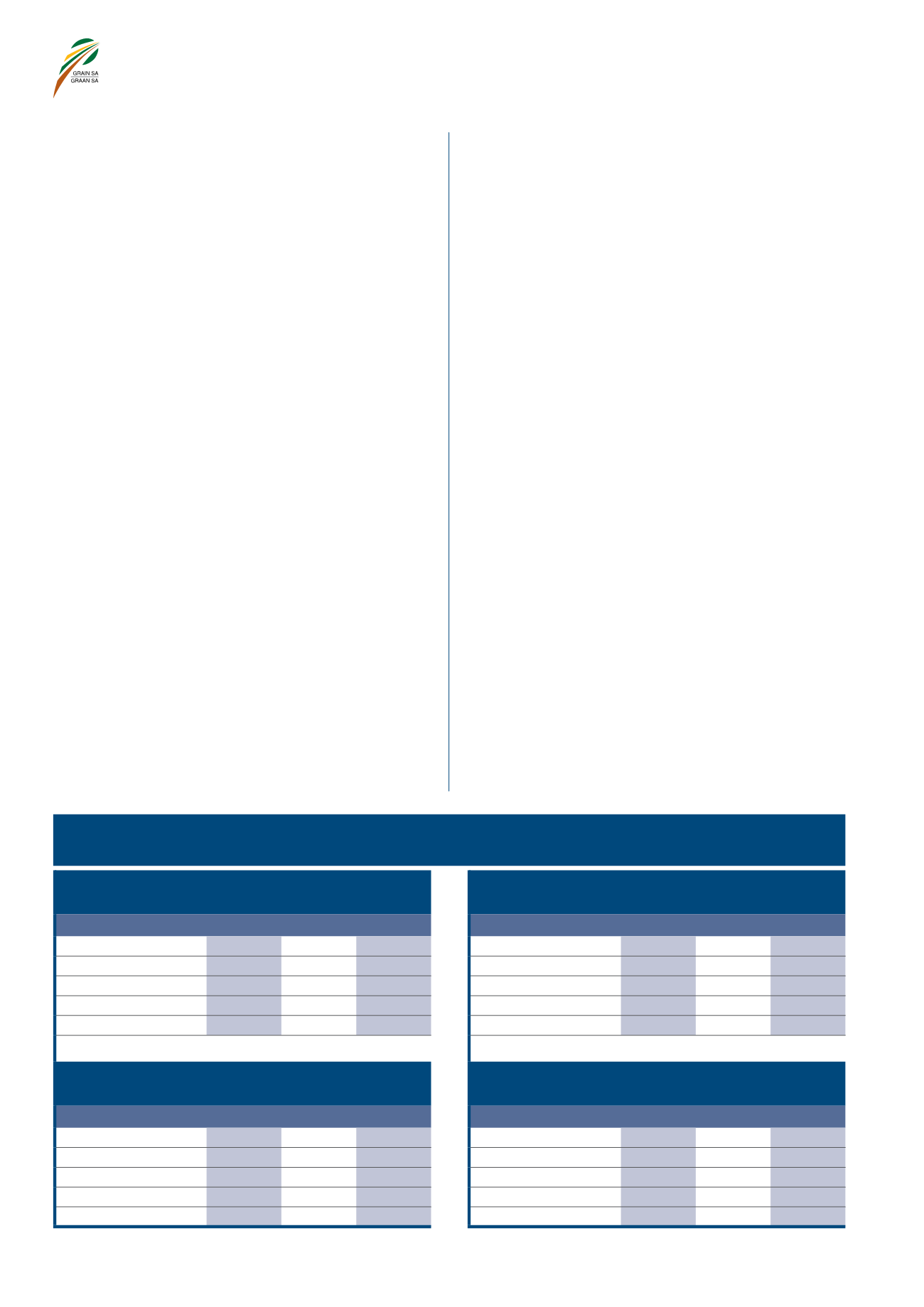

68
Agrochemical industry
PRICES
Almost 100% of the active ingredients required to manufacture local
agricultural chemicals are imported to South Africa. Therefore, the
international prices and exchange rate are monitored as it plays an
important role in domestic price trends.
Table 4
shows the international prices of the active ingredients of five
herbicides used in maize. The prices are in both dollar terms as well as
in rand terms.
Except for trifluralin, international herbicide price trends show decreases
year-on-year. From September 2018 to September 2019, international
prices of glyphosate decreased by 20,1%, while acetochlor, atrazine
and metolachlor also indicated decreases of 17,6%, 8,4% and 11,6%,
respectively. Trifluralin was the exception, increasing by 14,9%. In the
same period under review, the rand/dollar exchange rate weakened by
1% and the impact of the depreciation can be seen when international
dollar prices are converted to rand, which meant the decreases were in
line with dollar terms.
Table 5
indicates international insecticide prices, which are also used
in maize production (dollar and rand terms). Imidacloprid, lambda-
cyhalothrin show considerable decreases of 22%, 18,2% while
deltamethrin shows a moderate decrease of 6,7% and carbofuran
increased by 14,9%. International prices in rand terms showed the same
effect with weakening of the exchange rate.
ANNUAL MEETING WITH THE CROP PROTECTION INDUSTRY
On 29 July 2019, Grain SA’s Production/Input Working Group met with
CropLife, and the following issues were discussed:
Market trends in the grain industry and production costs for the
2019/2020 production season.
CropLife strategy.
International and local situation in the agrochemical industry.
Price trends and availability of agrochemicals.
NAMC value chain study.
Progress with normal registration.
CropLife waste management programme.
Clear indications of active ingredients on labels for chemicals
– uniformity of a product throughout the season and colours of
drum caps.
TABLE 4 – International herbicide prices – year-on-year change (September 2018 - September 2019).
TABEL 4 – Internasionale onkruiddoderpryse – jaar-tot-jaar-verandering (September 2018 - September 2019).
SEPTEMBER
2018
SEPTEMBER
2019 % CHANGE
USD/ton USD/ton
%
Glyphosate (95%)
4 467
3 569
-20,1
Acetochlor (92%)
3 680
3 033
-17,6
Atrazine (97%)
3 359
3 075
-8,4
Metolachlor (97%)
3 750
3 315
-11,6
Trifluralin (95%)
4 854
5 576
+14,9
International herbicide prices – year-on-year change
SEPTEMBER
2018
SEPTEMBER
2019 % CHANGE
R/ton
R/ton
%
Glyphosate (95%)
65 615
52 968
-19,3
Acetochlor (92%)
54 057
45 012
-16,7
Atrazine (97%)
49 346
45 640
-7,5
Metolachlor (97%)
55 093
49 199
-10,7
Trifluralin (95%)
71 310
82 741
+16,0
SEPTEMBER
2018
SEPTEMBER
2019
% VERAN-
DERING
USD/ton USD/ton
%
Glifosaat (95%)
4 467
3 569
-20,1
Asetochloor (92%)
3 680
3 033
-17,6
Atrasien (97%)
3 359
3 075
-8,4
Metolachloor (97%)
3 750
3 315
-11,6
Trifluralien (95%)
4 854
5 576
+14,9
Internasionale onkruiddoderpryse – jaar-tot-jaar-verandering
SEPTEMBER
2018
SEPTEMBER
2019
% VERAN-
DERING
R/ton
R/ton
%
Glifosaat (95%)
65 615
52 968
-19,3
Asetochloor (92%)
54 057
45 012
-16,7
Atrasien (97%)
49 346
45 640
-7,5
Metolachloor (97%)
55 093
49 199
-10,7
Trifluralien (95%)
71 310
82 741
+16,0
Landbouchemikalieëbedryf
PRYSE
Bykans 100% van die aktiewe bestanddele wat nodig is om plaaslike
landbouchemikalieë te vervaardig, word na Suid-Afrika ingevoer. Die
internasionale pryse en wisselkoers word dus gemoniteer, aangesien dit
’n belangrike rol in plaaslike prystendense speel.
Tabel 4
hieronder toon die internasionale pryse van die aktiewe
bestanddele van vyf onkruiddoders wat by mielies gebruik word. Die
pryse is in dollar- sowel as in rand-terme.
Buiten vir trifluralien, toon internasionale onkruiddoderpryse dalings op
’n jaar-tot-jaar-grondslag. Vanaf September 2018 tot September 2019
het die internasionale pryse van glifosaat met 20,1% gedaal, terwyl
asetochloor, atrasien en metolachloor ook dalings van 17,6%, 8,4% en
11,6% onderskeidelik toon. Trifluralien was die uitsondering en het met
14,9% gestyg. In dieselfde oorsigtydperk het die rand/dollar-wisselkoers
met 1% verswak, en die impak van die daling kan gesien word wanneer
internasionale dollar-pryse na rand omgeskakel word, wat beteken dat
die dalings in ooreenstemming met dollar-terme was.
Tabel 5
toon die internasionale pryse van insekdoders wat ook in
mielieproduksie gebruik word (dollar- en rand-terme). Imidaklopried en
lambda-sihalotrien toon aansienlike dalings van 22% en 18,2%, terwyl
deltametrien ’n matige styging van 6,7% toon, en karbofuraan met
14,9% gestyg het. Internasionale pryse in rand-terme illustreer dieselfde
uitwerking met die verswakking van die wisselkoers.
JAARLIKSE VERGADERING MET DIE GEWASBESKERMINGSBEDRYF
Op 29 Julie 2019 het Graan SA se Produksie/Inset-werkgroep met
CropLife vergader en die volgende sake is bespreek:
Marktendense in die graanbedryf en produksiekoste vir die 2019/
2020-produksieseisoen.
CropLife-strategie.
Internasionale en plaaslike situasie in die landbouchemikalieëbedryf.
Prystendense en beskikbaarheid van landbouchemikalieë.
NLBR-waardekettingstudie.
Vordering met normale registrasie.
CropLife-afvalbestuursprogram.
Duidelike aanduidings van aktiewe bestanddele op etikette vir
chemikalieë – eenvormigheid van ’n produk regdeur die seisoen en
kleure van dromme se proppe.


















